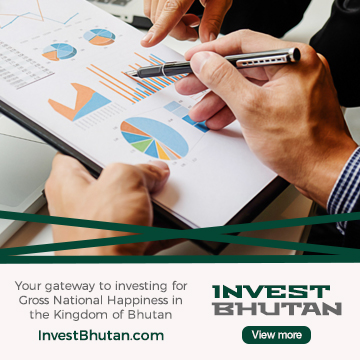Latest
News
Her Majesty Queen Jetsun Unveils Bhutan’s Soul in Pictures
On 13 November 2025, Her Majesty Queen Jetsun Pema Wangchuck launched Bhutan: Portrait of a Kingdom, a breathtaking photography book...
Royal Monetary Authority Unveils New Banknote Series Honouring the Fourth King
The Royal Monetary Authority of Bhutan introduces a new series of Ngultrum banknotes to commemorate the 70th Birth Anniversary of His...
Features
Passion and Purpose: From Traditional Rituals to Wellness Doctor at Bhutan Spirit Sanctuary
From humble beginnings in Eastern Bhutan to guiding guests at a five-star wellness sanctuary, Dr. Kelzang Dorji shares how compassion,...
Breaking Barriers: Draktsho Students Showcase Their Art in Thimphu
Students from Draktsho East in Kanglung, Trashigang, are showcasing their artwork in Thimphu as part of Ani Pema Deki’s “A Woman with...
Business
Bhutan’s Clean Energy Boom and Future Power Outlook
Bhutan is entering a new era of clean energy with major commitments from Adani, Reliance, and Tata to develop large-scale hydro and solar...
Lee Kum Kee Expands Global Culinary Initiative to Bhutan
Lee Kum Kee launches its Global Culinary Immersion Programme in Bhutan, empowering Bhutanese youth through hands-on culinary exchange,...
Sports
NBA Stars Visit Bhutan: A Historic Slam Dunk for Local Basketball
For the first time in history, four NBA players have visited Bhutan, igniting nationwide excitement and inspiring a new generation of...
Zimbiri Makes History as First Bhutanese Woman Elected to SAFF Executive Committee
Zimbiri has made history as the first Bhutanese woman elected to the South Asian Football Federation (SAFF) Executive Committee, a landmark...
Tourism
Three Bhutanese Hotels Honoured with MICHELIN Keys 2025
Bhutan shines on the global stage as three of its luxury hotels—Gangtey Lodge, Amankora Bhutan, and Six Senses Bhutan—earn coveted MICHELIN...
Bhutan Rises to Fourth in Condé Nast Traveller’s Best Countries List
Bhutan ranks fourth in Condé Nast Traveller’s Best Countries in the World list, celebrated for its serene landscapes, Gross National...
Lifestyle
Bhutan Celebrates World Music Day with a Soulful Gathering in Thimphu
Bhutan marked World Music Day with a vibrant concert in Thimphu, featuring over 90 artists despite the rain. Discover how music is shaping...
What's in a Name? Discover Bhutan's Unique Naming Tradition
In Bhutan, names are traditionally given by monks and not tied to family lineage. Visitors can experience a traditional naming ceremony at...
GMC
Groundbreaking Ceremonies of Two Spiritual Projects in Gelephu Mindfulness City
The Kangyur Labyrinth and Kesang Do Ngag Shedrupling held their groundbreaking ceremonies in Gelephu, marking major milestones in the...
Gelephu Mindfulness City Partners with Khaitan & Co to Strengthen Legal Confidence for Investors
Gelephu Mindfulness City partners with Khaitan & Co to enhance investor confidence and establish a transparent legal framework supporting...
